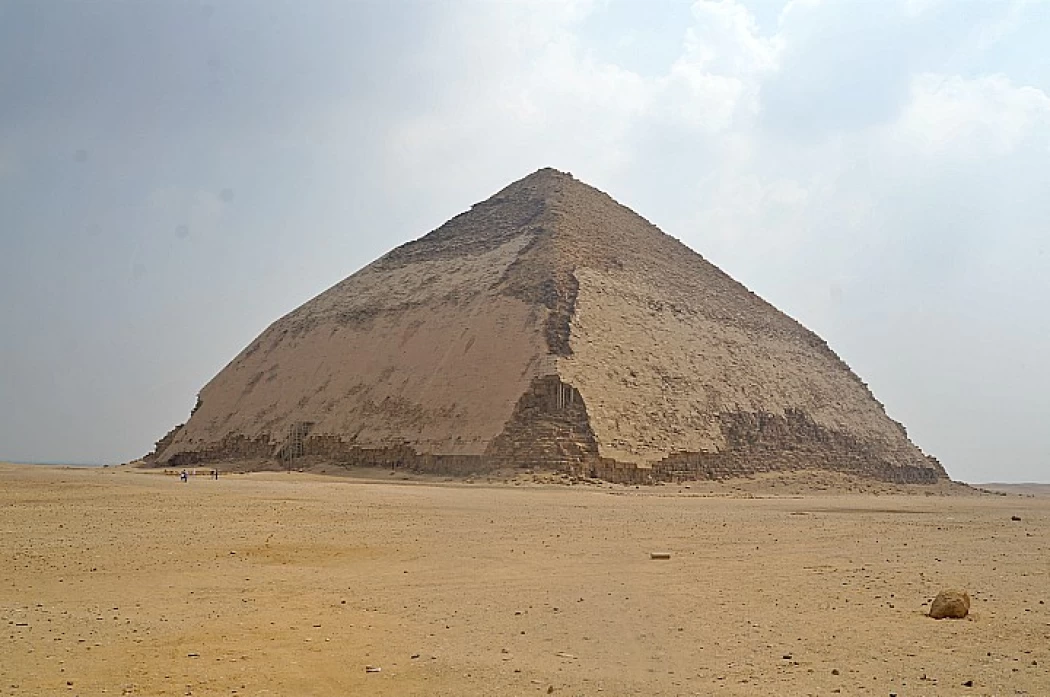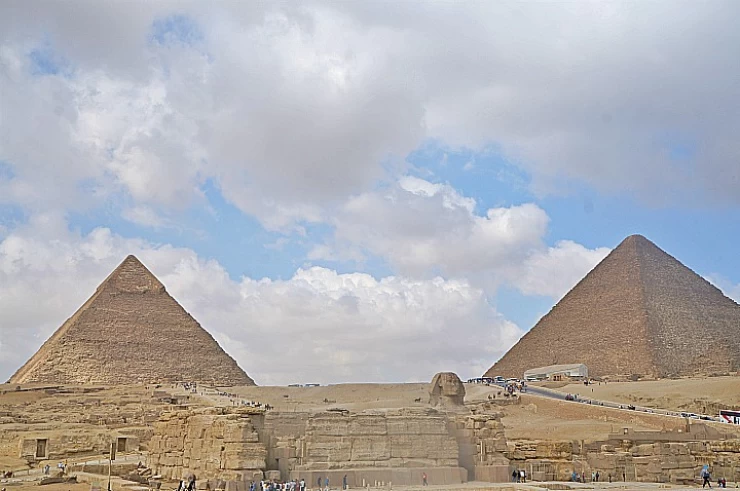
Come furono costruite le grandi piramidi? | Mito delle piramidi
Come furono costruite le grandi piramidi?
In questo articolo, ti mostreremo come sono state costruite le Piramidi di Giza?
Gli antichi egizi usavano un gran numero di manodopera nella costruzione delle piramidi hanno partecipato alla costruzione della Piramide di Cheope che risalgono alla 4a dinastia durante l'antico regno dell'antico Egitto storia e si trova a Giza tra 20.000 a 30.000 uomini, che durò circa 23 anni, va notato che non furono gli schiavi che parteciparono alla sua costruzione, ma quelli che parteciparono alla sua costruzione sono uomini liberi, erano esentati dal pagamento delle tasse, oltre a dare loro vestiti, alloggio e gratis cibo, hanno ricevuto tutto ciò in riconoscimento dei loro sforzi e per incoraggiarli a continuare il loro lavoro senza interruzioni. Gli operai usavano una varietà di strumenti per tagliare i blocchi utilizzati nella costruzione delle piramidi, inclusi martelli di granito e scalpelli di rame.
Mito delle piramidi
Costruendo attraverso la sabbia con l'aiuto di grandi slitte di legno, vengono tirati sulla sabbia bagnata, il che riduce della metà la forza di trascinamento. I costruttori di piramidi costruirono scale di mattoni di fango e poi le coprirono con scaglie di cera per indurire la loro superficie, in modo che potessero tirare le pietre fino a raggiungere il loro punto esatto nella piramide, e poi ripetevano quei gradini ogni volta che salivano.
Evidentemente potremmo dimostrare questo metodo come una ragione per vedere questo tipo di rampa in cima al primo pilone del Tempio di Karnak, visitata durante i tour di un giorno a Luxor e ad Assuan e una piramide incompiuta risale all'antico regno della storia dell'Egitto. regno di Djedefre.
Puoi goderti un tour alle Piramidi di Giza e al Museo Egizio oppure puoi combinare un tour di un giorno al Cairo alle Piramidi di Giza, Sfinge, Menfi, Sakkara e Dahshur. La Grande Sfinge di Giza può anche essere vista attraverso un tour di transito con scalo al Cairo, Cairo City Break, o anche se hai un tour di sosta al Cairo puoi spremere i tuoi tour dall'aeroporto del Cairo a un tour di mezza giornata delle piramidi di Giza e della Sfinge con giro in cammello.
Il nostro team vi aiuterà a viaggiare in Egitto e sperimentare il tempo soleggiato del nostro bel paese durante la Pasqua 2024, grazie alla loro vasta conoscenza del turismo egiziano. Puoi personalizzare il tuo pacchetto selezionando uno dei nostri pacchetti di viaggio in Egitto o sfruttare al massimo il tuo tempo in una breve visita, imparando di più sulla storia egiziana e le sue affascinanti storie e vivendola attraverso tour privati al Cairo. Partecipa a uno dei nostri tour economici in Egitto attraverso il deserto del Sahara, come i tour di Siwa dal Cairo, per esempio, o preferibilmente i tour nel Deserto Bianco d'Egitto. Scoprite i nostri tour di un giorno ad Assuan, fate una gita di un giorno da Assuan ad Abu Simbel, o viaggiate via terra e godetevi i nostri tour di un giorno a Luxor per vedere gli incredibili templi di Karnak, il Tempio di Luxor, il Tempio di Hatshepsut, e vedete le meravigliose tombe splendidamente dipinte nella Valle dei Re, questo è il luogo dove i re e i governanti del nuovo regno riposano in pace e imparate i loro riti di mummificazione e sepoltura.
The Construction Mechanisms of the Pyramids: Estimating the Engineering Feats of the Ancient Egyptians
The Giza Pyramids are some of the greatest buildings that were ever designed and built, and the workforce that existed in those days was just extraordinary and incredible. These massive structures, particularly the Giza period pyramid, have puzzled historians, archeologists, and engineers for many ages, imbued with the perennial query of how such structures were even raised in the first place. These constricting structures were lifted by ancient people exercising modern-day power, construction engineering, and most fundamentally, physics and material science.
In this paper, let us specifically deal with the Giza Pyramids, their construction and techniques that were employed, the tools brought in, and the people present in the country.
The Workforce Behind the Pyramids: Myth vs. Reality
A widely held belief that the Pyramids were built by slaves has been proven to be false by recent studies. The Great Pyramid of Cheops (Khufu), which was constructed within the fourth dynasty of Old Kingdom Egypt, was constructed by skilled laborers and not by slaves. Estimates have suggested that between 20,000 and 30,000 men took part in the construction work, and this lasted about twenty-three years.
Rather than being enslaved, these workers received proper payments for their work. More so, they were also given accommodation, food, and clothing in return for their services, which included a tax waiver. These were aimed at ensuring that they took part actively in the building of the pyramid for as long as it took and appreciating their input.
Instruments and Components
The builders of the pyramids may have had a whole arsenal of cutting and measuring tools to cut and shape the large die stones, which are the building blocks of the pyramids. However, while the shell of most pyramids was built of limestone, the core of these structures was more advanced materials, especially granite, which required more sophisticated tools. There was a granite hammer to first carefully shape the rock statues, a few basic copper chisels, and other items that were quite artistic with stone engraving.
One of the main challenges in the process of building the pyramids was that they not only had to be built, but there were massive stone slabs to be carried, which weighed about 15 tons each, among others. It is believed that the ancients would use wooden sleds and load the stone blocks on them and then drag the blocks over the sand. Watering the sand ahead of the sleds was another technique since this reduced the resistance to pulling the stones. Studies revealed that this method of wetting the sand can help reduce the force of pulling by as much as fifty percent, making it very convenient to move heavy stone blocks.
The Use of Ramps in Pyramid Construction
One of the most fascinating techniques that the Egyptians used in the construction of the pyramids was the application of ramps. Workers made use of rampways made of mud bricks with a coating of wax chips to enhance the durability of the surface. These ramps enabled the workers to pull the heavy stone blocks to the higher levels of the pyramid and, more so, to position them correctly.
This process would be repeated layer after layer of stones until the pyramid reached its full height, with additional ramps being constructed to enable the lifting of stones. These ramps played an important role in the whole process of construction, and remains of such ramps have been discovered in other parts of Egypt, including temples like the Karnak Temple in Luxor and an incomplete pyramid from the period of Djedefre, both from the Old Kingdom.
The historical ramps' construction principles have neither been agreed upon nor dismissed by historians and engineers. Some contend straight “runners” could be built on one face of the pyramid; others contend a more complicated set of systems, including zigzag-forming runners or even runners that wrapped around the pyramid. In whatever shape, designed, and built, these ramps were major for moving the heavy stone blocks to the more elevated sections of the pyramid.
The most interesting thing about the Giza Pyramids is the way they were built perfectly, and their alignment was unquestionable. The Great Pyramid has its sides aligned to face the four cardinal points of the compass with unimaginable precision, a task that would be beyond someone who didn’t understand geometry and astronomy at an advanced level.
To avoid the bulging of the pyramid while building it, the ancient Egyptians probably made use of various measuring devices like plumb lines and set squares. The sharpness of the design is illustrated by the almost equal size of the base and the extreme rise of
the sides of the pyramid, which remain unchanging even at higher levels.
For many centuries, the successful execution of this alignment has been a subject of admiration and wonder. The angles are strikingly accurate, and the mathematical proportions of the construction allow one to understand why the ancient Egyptians were geometry masters and how to build from the bottom of the pyramid to its peak while preserving its shape.


















